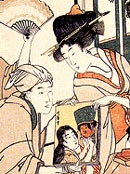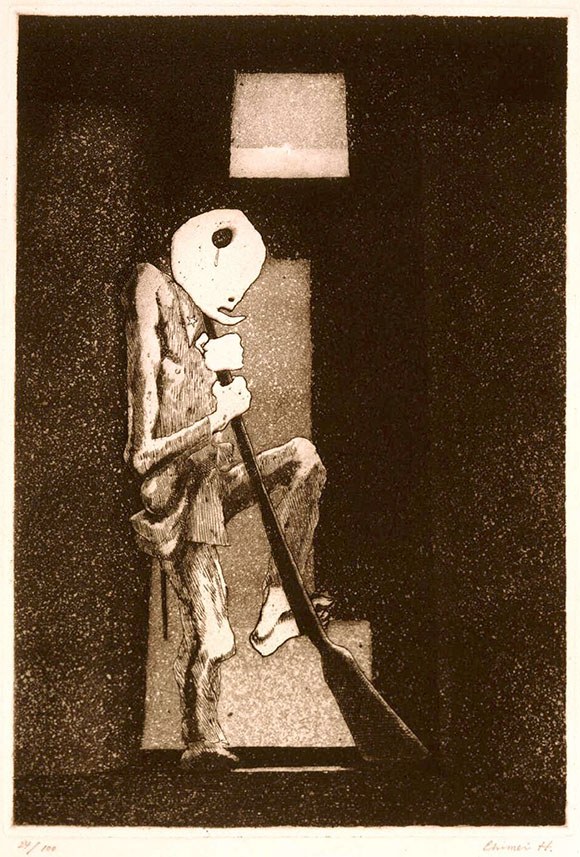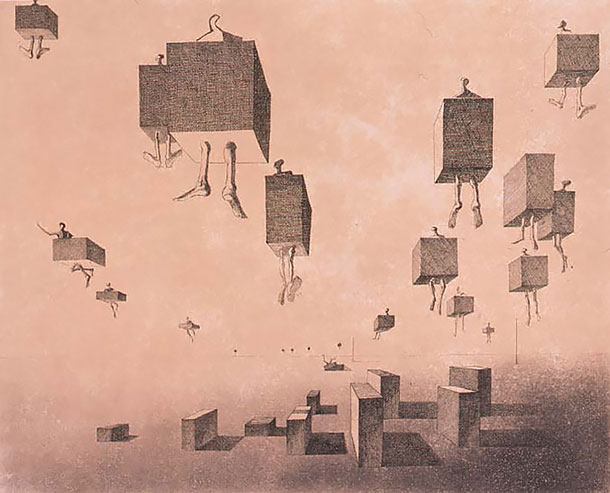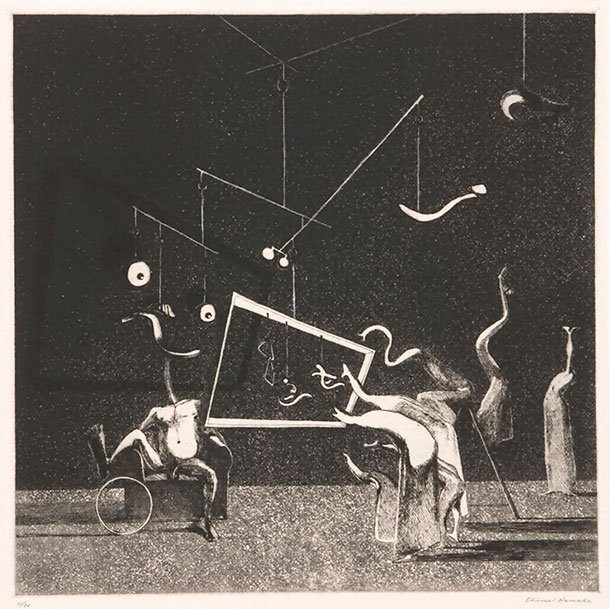

HAMADA Chimei (浜田知明)
|
Hamada Chimei (浜田知明 1917-2018), born in Kumamoto Prefecture, was a surrealist and satirical print artist, although from 1983 he also produced bronze and mixed-media sculptures as trenchant commentaries on modern society. Hamaada graduated from the oil painting department in the Tokyo Fine Arts School (Tokyo Bijutsu Gakkô: 東京美術学校). In 1964 he traveled to Europe and by the time he returned to Japan in 1965, he had become an honorary member of the print department of the Florence Academy of Fine Arts (Italy). Above all, Hamada became famous for his copper-plate prints portraying hellish scenes based on his experiences as a conscript for five years during the second Sino-Japanese War (1937-1945). His caustic series "Elegy for new recruits" (Shonen-hei aika: 初年兵哀歌) from 1951-1954 draws upon witnessing Japanese atrocities in China, which Hamada called "demonic." He said that what he encountered was "the darkness of the [Japanese] Middle Ages transported into the present."
 |
| Hamada Chimei: Shonen-hei aika (Hoshô): 1954 Elegy for a New Recruit (Sentinel): 初年兵哀歌(歩哨), ed: 100 (238 × 162 mm) Series: Shonen-hei aika ("Elegy for new recruits": 初年兵哀歌) Dôbanga (copper-plate print: 銅版画), etching and aquatint (エッチング、アクアチント) (Awarded second prize at the Fourth Lugano International Print Biennale, 1956) |
After World War II, Hamada returned to his hometown of Kumamoto and worked as a teacher at the Kumamoto Commercial High School. However, in 1948, he moved to Tokyo and soon joined the Free Artist Association (Jiyû Bijutsuka Kyôkai: 自由美術家協会). The association was founded by the artists Yamaguchi Kaoru (山口薫 1907–1968), Saburô Hasegawa (長谷川三郎 1906-1957), Hamaguchi Yôzô (浜口陽三 1909-2000), and others in 1937.
Hamada also participated in Sekino Jun'ichirô's so-called "copper-plate research group" after Sekino set up an etching press in the kitchen of his home in 1951. Sekino taught intaglio printmaking to students and invited fellow artists to experiment, including Hamada, Hamaguchi Yôzô (浜口陽三 1909-2000), Kobayashi Donge (小林ドンゲ born 1926), and Komai Tetsurô (1920-1976). Two years later, in 1953, the professionals in the group established the Japanese Copper-plate Print Association (Nihon Dôbanga Kyôkai: 日本銅版画協会), with Sekino as its leader and Hamada among the most highly skilled members.
Recognition for Hamada came with the aforementioned copper-plate print series "Elegy for new recruits" (Shonen-hei aika: 初年兵哀歌) exhibited at the 1951 Free Artist Association Exhibition. The series would eventually include a total of 15 works by 1954. Among them, the harrowing 1954 "Sentinel" (Hoshô: 初年兵哀歌 歩哨) received high praise and was awarded second prize at the 1956 Lugano International Print Biennale (see image above). In this depiction, a skeletal Japanese soldier stands with one toe positioned near the trigger of a rifle aimed at his throat as a teardrop falls from his empty eye socket. Hamada claimed that because he was "constantly thinking of killing myself, I tried this pose while standing sentry at night. This is almost a self-portrait" (see Aijiko ref., p. 75).
An assessment of Hamada's Shonen-hei aika series from an exhibition of his work at the Museum of Modern Art, NY in 2015 declared, "Hamada transmuted the barbarity he saw into a comedic theater of cruelty." The exhibition reviewer also stated that, "The decision to work in etching for this series was purposeful, as Hamada likened the process of an image emerging from an ink-covered etching plate to that of smoke clearing on the battlefield." A few years earlier, another researcher concluded that, "Hamada imbued his plates with a surreal and sometimes Otto Dix-like expressionism.... The copper plate print involves touching, manipulating, and wounding a surface with acid ... and has aggressive connotations best suited to [Hamada's] war-based images." (see Kirker ref.)
 |
| Hamada Chimei: Torihiki jûga no kage (In the Shadow of the Rifle Stand: 銃架のかげ), 1951 Dôbanga (copper-plate print: 銅版画), etching and aquatint (エッチング、アクアチント) Edition: 50 (plate mark: 200 × 175 mm) |
A second example from the Shonen-hei aika series is titled "In the Shadow of the Rifle Stand" (Torihiki jûga no kage: 銃架のかげ), an etching and aquatint from 1951 (shown above). Hamada described this surrealist work, saying, "Rifles, the symbols of the army, [are] lined up. In their shadows caterpillars lifelessly creep about. New recruits, beaten everyday and deprived of their freedom, were just like caterpillars. Outside the iron grids stands a sentry as if keeping watch over the miserable soldiers" (see Aijiko ref. below, p. 72).
One of Hamada's most notable works from the 1950s is his large, surrealist print called "Flight" or "Soaring" produced in 1958 (shown below). Human-like figures with faceless heads are encased within cubes as they soar in the sky above a barren landscape. Additional forms on the ground seem to suggest tombstones. Perhaps Hamada meant to express the feeling of utter futility on the part of men trapped inside wrongdoings of their own making. It is a world of human loneliness and alienation, devoid of touch or tenderness. Among the known impressions of this design, there are various colorations, including a monochrome gray and black, the pale rose shown here, a strong orange-red, and finally a moderate blue.
 |
| Hamada Chimei: Hishô ("Flight" [also called "Soaring"]: 飛翔), 1958 Dôbanga (copper-plate print: 銅版画), etching and aquatint (エッチング、アクアチント) Edition: 50 (plate mark: 356 × 451 mm) |
Another early prize singled out the Hamada etching and aquatint "Blind Men" (Gunmô: 群盲). This startling image received the "Award of Excellence" at the Fourth Contemporary Japanese Art Exhibition (Dai 4-kai Gendai Nihon Bijutsu-ten: 第4回現代日本美術展) in 1960. In this bizarre scene, slug-like creatures appear to be viewing a framed picture dangling before them. Opposite these figures is a naked man with an elongated neck whose eyes, nose, and mouth are suspended above his body as part of a mobile. Hamada once said that "human beings are always aware that they can only see the world from a single point of view, position, or belief." Perhaps the idea here is that these creatures are blind to other perspectives while they are being manipulated toward a narrow point of view by a sort of circus-master controlling the scene they are so intently observing.
 |
Hamada Chimei: Gunmô (Blind Men: 群盲), 1960 |
Hamada's earliest retrospective was the "Exhibition of Chimei Hamada Copperplate Prints 1938-1975" (Hamada Chimei dôbanga sakuhin 1938-1975 ten: 浜田知明銅版画作品 1938-1975 展) held in 1975 at the Kitakyushu City Museum of Art (北九州市立美術館). In 1989, Hamada received the Arts and Culture Medal (Chevalier) from the French government. The British Museum, London held a retrospective exhibition of 100 prints and 16 sculptures in 1993, and the following year, another retrospective, also including his sculptures, called "Exhibition of prints and sculptures by Hamada Chimei" (Hamada Chimei-ten hanga, chôkoku zen sakuhin tenji: 浜田知明展 版画,彫刻全作品展示), was given at the Kumamoto Prefectural Museum of Art (熊本県立美術館). Hamada had another comprehensive retrospective of his copper-plate prints at the Museum of Modern Art, Kamakura organized under the title "Chimei Hamada Copper Prints―From 'Elegy for a new conscript' to 'Deal'.” The largest showing of Hamada's works was titled "The World of Hamada Chimei: Elegy and Humor in Prints and Sculptures" (Torihiki Hamada Chimei no sekai-ten hanga to chôkoku ni yoru kanashimi to yûmoa: 浜田知明の世界展 版画と彫刻による哀しみとユーモア). It took place in July-September, 2010 at the Kanagawa Prefectural Museum of Modern Art (神奈川県立近代美術館), which presented 330 works (173 prints, 73 sculptures, 4 oil paintings, and 80 drawings and preparatory materials).
The "Deal" (just mentioned above) refers to the 1979 copper-plate print shown below. Two men, presumably war profiteers, are concluding a backroom deal as war planes fly overhead. Each is being handed a bag of money by accomplices in the dark shadows on either side of the seated men. One of the conspirators gives a thumbs up, and so it goes, corrupt and heartless opportunists profiting, often in secret, from the murderous impulses and suffering of others.
 |
| Hamada Chimei: Torihiki (Deal: 取引), 1979 Dôbanga (copper-plate print: 銅版画), etching and aquatint (エッチング、アクアチント) Edition: 30 (206 × 268 mm) |
Starting in 1983, Hamada began making bronze or mixed media sculptures in small formats. The example shown here, from 1995, is called "Portrait of an artist" and stands only 375 mm high. In the manner of a Dadaist or surrealist assemblage, Hamada has constructed a mechanical device made of gears and paintbrush holders as a stand-in for the human artist. What this says about the state of contemporary society or fine art in Hamada's view is open to interpretation, but surely this absurdist concoction was intended to be satirical as well as whimsical.
 |
| Hamada Chimei: Portrait of an artist, 1995 Bronze and mixed media (375 x 375 x 167 mm) |
In 1996 an exhibition of Hamada's complete works (Hamada Chimei no zen'yô-ten, 浜田知明の全容展) was held, co-sponsored by the national newspaper Asahi Shinbun and four museums: Odakyu Museum of Art; Museum of Modern Art, Toyama; Shimonoseki City Museum of Art; and Itami City Museum of Art. That same year, Hamada provided an oral history (Nishi-Nihon Shinbon Co.). In 2008, Hamada was the first Japanese printmaker to be exhibited at, and have his works acquired by, the Uffizi Gallery in Florence, Italy. Late in life, on August 4, 2013, Hamada gave a 45-minute interview ("Message from Hamada Chimei, 95-year-old printmaker") that was aired by the Nihon Hôsô Kyôkai [NHK] Nichiyô Bijutsukan (Japan Broadcasting System, Sunday Art Museum: 日本放送協会 日曜美術館).
Impressions of Hamada's prints are in important public institutional collections, including the Art Gallery of New South Wales; British Museum, London; Cincinnati Art Museum; Fine Arts Museums of San Francisco; Hiroshima City Museum of Contemporary Art; Honolulu Museum of Art, Hawai'i; Kumamoto Prefectural Museum of Art; Museum of Contemporary Art, Tokyo; Museum of Modern Art, Kamakura and Hayama; Museum of Modern Art, NY; National Museum of Modern Art, Kyoto; and Yokohama Museum of Art. © 2020 by John Fiorillo
BIBLIOGRAPHY
- Ajioka, Chiaki; Kuwahara, Noriko; Nishiyama, Junko: Hanga: Japanese Creative Prints. Art Gallery of New South Wales, 2000, pp. 71-77, nos. 4.1.i to 4.1.vii and 4.1 to 4.4.
- Kirker, Marjorie: Printmaking as an Expanding Field in Contemporary Art Practice: A Case Study of Japan, Australia, and Thailand. 2009 [PhD Thesis] Queensland University of Technology, pp. 78, 80.
- Hamada, Chimei: Hamada Chimei sakuhin shû (Collected works of Hamada Chimei: 浜田知明作品集). Tokyo, 1982.
- Kawakita, Michiaki: Contemporary Japanese Prints. [Trans. by John Bester] Tokyo: Kodansha, 1967, pp. 148-149, nos. 109-111.
- Kumamoto Kenritsu Bijutsukan (ed.): Hamada Chimei no subete (All About Hamada Chimei). Kumamoto Kenritsu Bijutsukan (Kumamoto Prefectural Museum of Art: 熊本県立美術館), 2015.
- Yoshida, Hiroshi: Jin to jidai o mitsumete — Hamada Chimei kikigaki (Looking at people and the times: A memoir by Hamada Chimei: 人と時代を見つめて: 浜田知明聞書). Fukuoka: Nishi-Nihon Shinbunsha, 1996, pp. 79, 115-116, 119, 125.
Viewing Japanese Prints |